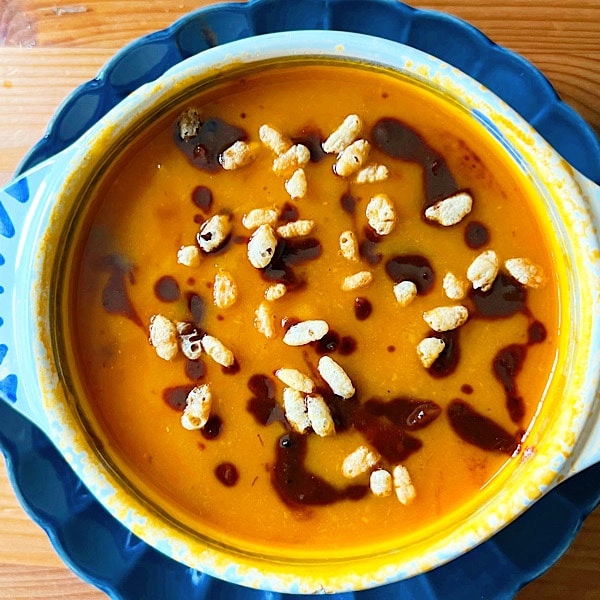Once, when I was in my 20’s, I tried to make my own fig bars. They were a whole lotta work for precious little pay-off because they didn’t look or taste anywhere near as good as store bought. Not worth it, I branded the recipe.
Fast-forward to a moment recently in the kitchen when I was trying to think of ways to use quince. Cooked quince can be tricky because of its dense, granular texture – I love it, but not everyone finds it pleasant. Kinda like dried figs, I thought…and decided to revisit the fig bar idea, only with quince instead. The recipe wasn’t anywhere near as hard as I remembered (I was young and inexperienced back then). The dough was forgiving, the results were fabulous – and I got a generous 20 or so cookies from a small batch of dough. Even the quince detractors in my entourage have been enthusiastic and asked for more. My plan now is to make a big batch of filling and freeze it so I can make Quince Newtons throughout the winter.
Filling
2 cups/400 g.) cored quince slices (preferably precooked)
1 cup/200 g. sugar
½ cup water
Dough
¼ cup/60 g. softened butter
½ cup/100 g. sugar
1 egg
½ tsp. vanilla, optional
¼ tsp. baking soda
1/8 tsp. salt
1 ¼ cups/190 g. flour
To make the Filling: Place all the ingredients in a small saucepan, cover, and cook over medium heat 30 minutes, stirring occasionally to break up the quince as it cooks. When the purée is applesauce consistency and dry enough to pull away from the bottom of the pan, remove it from the heat, and let cool completely in the pan (covered).
Meanwhile, make the Dough: Beat the butter and sugar together with an electric mixer until creamy. Add the egg and the vanilla (if using), and beat until smooth. Beat in the baking soda and the salt, then fold in the flour until just combined. Scrape the dough out of the bowl, flatten into a square, and wrap in parchment paper. Chill at least 1 hour.
Place the chilled dough on a well-floured work surface, and roll out into an 8-inch/20-cm wide rectangle. Cut the rectangle in 2 lengthwise, and set the lengths on a piece of parchment paper the size of the baking sheet you plan to use. Spread about ½ cup of the cooled quine filling down the center of each dough strip, then fold the sides over and pinch the dough closed to make 2 flat logs. Place the parchment with the logs on the baking sheet, and chill ½ to 1 hour.
Preheat the oven to 350˚F. Place the parchment sheet with the quince logs on the work surface, flip the logs over, then cut each log lengthwise into 1- 1½-inch/3-4 cm rolls/cookies. Place the parchment on the baking sheet once more, spread the rolls out on the parchment, then bake 20 to 25 minutes, or until the cookies are golden brown. Cool on the baking sheet, then store in an airtight container. Makes 20 quince newtons.





Just made these (over several days – I like to do one thing at a time). They are even better than I expected!!! Absolutely perfect and so satisfying!
Not sure if this is still updated, but there’s a mistake on the imperial to metric conversion for the flour. 1.25 cups of flour is 156 g, not 190 g.
Hi Stephanie, I actually go by Nigella Lawson’s flour conversion of 1 cup = 150 g. I find it’s the most reliable in getting recipes to work. Then I rounded up the ¼ cup to 40 g. for simplicity sake.
Interesting! I made this with 190 g the first time and had to add an extra egg because it wasn’t even close to dough, it was barely dry flour. I’m mid-way through making it tonight with 160 g, and it’s made a dough as I expected. Either way, they are amazing cookies — we made our entire (very small) quince haul into filling and are rationing the three batches of cookies that we can make throughout the year.
Thank you for your kind words about the recipe! The flour seems to be an issue – as it is with many doughs. Good thinking on adding the extra egg and then on reducing the flour.
I made these as instructed. The dough was too soft. The cookies didn’t hold their shape in the oven. Next time I will just add a little more flour.
Oh dear! The flour issue is a tricky one apparently for this recipe – I make it in France and don’t have a problem but your flour may not absorb as much liquid. I hope it works out with a little more flour and my apologies – there’s nothing worse than trying a new recipe and having it not work!